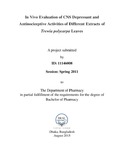| dc.contributor.advisor | Ripa, Farhana Alam | |
| dc.contributor.author | Akter, Nahid | |
| dc.date.accessioned | 2015-11-29T07:30:57Z | |
| dc.date.available | 2015-11-29T07:30:57Z | |
| dc.date.copyright | 2015 | |
| dc.date.issued | 2015-08 | |
| dc.identifier.other | ID 11146008 | |
| dc.identifier.uri | http://hdl.handle.net/10361/4661 | |
| dc.description | This project report is submitted in a partial fulfillment of the requirements for the degree of Bachelor of Pharmacy, 2015. | en_US |
| dc.description | Cataloged from PDF version of Internship report. | |
| dc.description | Includes bibliographical references (page 35-38). | |
| dc.description.abstract | Recently worldwide different researches on medicinal plants have grabbed attention. A number of experiments were found where medicinal plants have been used for different complementary and traditional systems to promote newer and safer drugs. Keep this in mind our current study was designed to find out CNS depressant and analgesic principles from different solvent extracts (Ethanol-ETTP, Chloroform-CHTP, Ethyl Acetate- EATP) of leaves of Trewia polycarapa. After completing phytochemical screening tests, we have noticed that the plant is a good reservoir of such compounds which have the possibility to be a better source of CNS depressant and analgesic therapeutic agents in living organism.
In our present study, we have checked above mentioned pharmacological activities of our experimental plant extracts in rodents. By the open field and hole cross method, CNS depressant activity was inspected with the decline of locomotor activity on mice. Analgesic activity was evaluated by acetic acid induced pain method as well as formalin induced pain method. Here crude extracts were administered to mice at a dose of 250mg/kg and 500mg/kg. All the results of our experiments were statistically significant (p<0.05). In CNS depressant activity tests, the movement of rodents decreased in a dose depending manner comparing to the standard diazepam. The experimental extracts also gave good analgesic effect comparing to control group and represented by decreased amount of writhes in acetic acid induced pain method as well as reduced licking time in formalin induced licking method. At 500 mg/kg dose, the ETTP extracts showed 60.24percent inhibition of writhing response compare to standard or reference indomethacin where 68.42 percent inhibition was observed. In conclusion we can say that our present findings suggest that ETTP, CHTP and EATP extracts of Trewia polycarpa leaves contain potent CNS depressant as well as analgesic therapeutic active principles. | en_US |
| dc.description.statementofresponsibility | Nahid Akter | |
| dc.format.extent | 38 pages | |
| dc.language.iso | en | en_US |
| dc.publisher | BRAC University | en_US |
| dc.rights | BRAC University project report are protected by copyright. They may be viewed from this source for any purpose, but reproduction or distribution in any format is prohibited without written permission. | |
| dc.subject | Pharmacy | en_US |
| dc.subject | CNS depressant | en_US |
| dc.subject | Trewia polycarpa | en_US |
| dc.title | In vivo evaluation of CNS depressant and antinociceptive activities of different extracts of trewia polycarpa leaves | en_US |
| dc.type | Project report | en_US |
| dc.contributor.department | Department of Pharmacy, BRAC University | |
| dc.description.degree | B. Pharmacy | |

